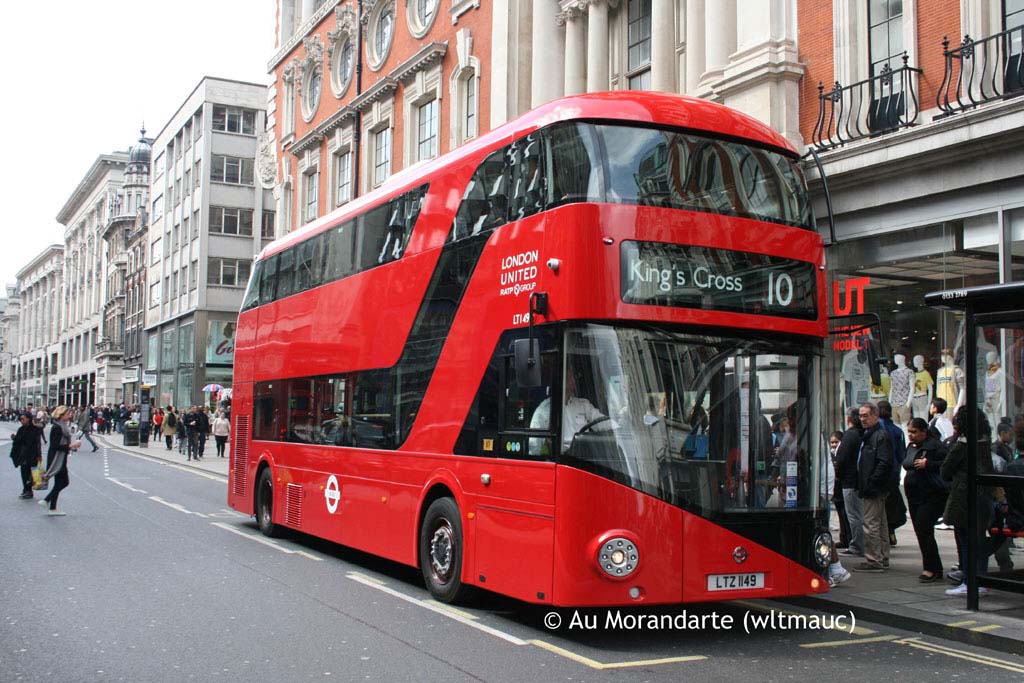 | Photo © Au Moran. |
Home | Bus routes | Operational details | Service changes | Operators & Garages | Photo gallery
A rare opportunity two introduce a new central London Routemaster route with a low number arose in the late 1980s after long-standing route 10 finally bit the dust. Routes 10 and 10A used to run from Victoria to Abridge and Epping respectively (unusually crossing the Thames twice on the way via Lambeth and London Bridges), with a combined allocation of around 50 buses. But the route gradually shrunk as sections of route were localised and the route finally disappeared altogether soon after suffering the ignominy of single deck conversion in 1987. Now one would have to travel by 507, 344/C10, 40, 25, 257, 66/145, W13 and then W14, 275, 167, 43 and 541 (10) or 20, 575 (10A) to replicate the route, and even that is not an exact match as roads such as Borough Road, Eagle Lane in Snaresbrook, Maybank Road in South Woodford and Chigwell Road are no longer served!
But all that is now history. The present route 10 was introduced in 1988, essentially as a split of route 73, to preserve the link between Hammersmith and Kensington and the West End, route 73 being diverted away from these areas to run to Victoria instead. The 10 also parallels the 9 for a substantial section between Hammersmith and Hyde Park Corner, and so the choice of route number was quite natural.
The initial route was over the 73 between Hammersmith and King’s Cross, and was run by the London United division. However, as work was lost at sister company London Northern, from April 1989 an allocation was introduced from Holloway garage at the other end of the route. For operational convenience the 10 was extended to the back of Holloway garage, via the traditionally rather badly served York Way and Brecknock Road. Initially this section did not run during early mornings, late evenings or Sundays, but a Sunday service was later added, following which journeys were extended to Archway rather than terminating in the back of the garage in Tufnell Park (Monnery Road). The service was then altered to garage journeys only, leaving local passengers to the only other service, the Monday to Saturday C12 running every 20 minutes. The withdrawal of the C12 in 1998 saw the full service running through to Archway.
As part of new London Mayor Ken Livingstone’s plans to introduce congestion charging, it was proposed to split the 10 in turn, which had become something of a monster to operate, cutting right across central London as it did. After some confusion about the numbering, the outcome was that the 10 was shortened to run once again between Hammersmith and King’s Cross, while the essentially local route between Archway and King’s Cross, and as far as Marble Arch, would be taken over by a new route 390. Surprisingly, it was the 390 that was to retain the Routemasters, while the 10 would gain new double deckers. Perhaps the logic was that the 10 would be able to provide a wheelchair accessible alternative to the 9 on the common section, still Routemaster operated at the time – but the substantially slower running speed of the 10 compared to the 9 must have caused problems.
The 10 was put out to tender, the existing contract for the route, with Metroline, being renumbered 390. The ‘new’ 10 was awarded to First for operation from Westbourne Park garage, although to start with buses had to be parked temporarily at the White City lorry park, effectively acting as an outstation of Westbourne Park. Making a substantial break with the long line of Trident/President combinations ordered by First for London use, the 10 received a batch of long wheelbase Volvo B7TLs with ALX400 bodywork.
Following expiry of the original contract the 'new' 10 was re-tendered and this time awarded to London United, perhaps a more obvious operator, which runs it from Stamford Brook alongside route 9. Initially, standard issue Scania OmniCity double deckers were employed, but these have now been replaced by New Bus for London vehicles, which are now entering squadron service. Route are selected for conversion to these buses on an entirely pragmatic basis, revolving around practicalities, contract dates and opportunities for redeployment of existing vehicles. Crucial to the 10 was that it had recently received a 2 year contract extension, and that London United had won another route (E3) onto which the SPs could be redeployed. LT149 (LTZ 1149) stops for passengers in Oxford Street on the first day of the new type, 26 April 2014.
 | Photo © Au Moran. |
As well as having operated the 10 when it first started replacing the eastern end of the 73, London United more recently ran the night equivalent, the N10, until the route was shortened and taken over by First. At that time the N10 ran from Archway to Richmond, the section from Hammersmith being via Putney owing to double deckers being banned from Hammersmith bridge. However, on transfer to First the N10 was cut back to King’s Cross as the 390 was introduced as a 24 hour service. TfL's desire for standardisation saw the 10 converted to 24-hour operation also, with a new night service on the 33 replacing the Richmond leg of the N10, obviating the need for the lengthy diversion via Putney. This change did nonetheless make many journeys much more difficult at night – as well as Sheen losing its direct service from central London, east-west journeys between Richmond/Sheen and Wandsworth/Clapham Junction now require two changes, or walking the length of Putney High Street to catch an N22.
Navigation
| Previous | Next | |
| Chronologically | C10 | 358 |
| Numerically | 6 | 15 |
Photo Gallery | Bus route list | Operational details | Service changes | Operators & Garages